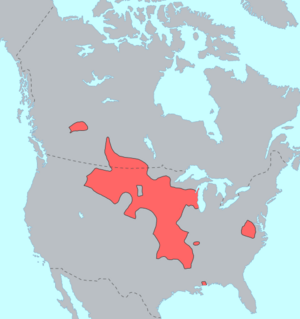Western Siouan languages facts for kids
Quick facts for kids Western Siouan |
|
|---|---|
| Siouan Proper | |
| Geographic distribution: |
central North America |
| Linguistic classification: | Siouan
|
| Subdivisions: |
Missouri River (Crow–Hidatsa)
Mississippi Valley (Central)
Ohio Valley (Southeastern)
|
 Pre-contact distribution of the Western Siouan languages
|
|
The Western Siouan languages, also called Siouan proper or simply Siouan, are a large language family native to North America. They are closely related to the Catawban languages, sometimes called Eastern Siouan, and together with them constitute the Siouan (Siouan–Catawban) language family.
Linguistic and historical records indicate a possible southern origin of the Siouan people, with migrations over a thousand years ago from North Carolina and Virginia to Ohio. Some continued down the Ohio River to the Mississippi and up to the Missouri. Others went down the Mississippi, settling in what is now Alabama, Mississippi and Louisiana. Others traveled across Ohio to what is now Illinois, Wisconsin, and Minnesota, home of the Dakota.
Family division
The Siouan family proper consists of some 18 languages and various dialects:
- Mandan †
- Nuptare
- Nuetare
- Missouri River Siouan (a.k.a. Crow–Hidatsa)
- Mississippi Valley Siouan (a.k.a. Central Siouan)
- Mitchigamea? †
- Dakotan (a.k.a. Sioux–Assiniboine–Stoney)
- Sioux – 25,000 speakers
- Assiniboine – 150 speakers
- Stoney – 3,200 speakers
- Chiwere-Winnebago
- Dhegihan
- Omaha–Ponca – 85 speakers
- Kansa-Osage
- Quapaw – 1 speaker
- Ohio Valley Siouan
(†) – Extinct language
Another view of both the Dakotan and Mississippi Valley branches is to represent them as dialect continuums.
All the Virginia Siouan dialects listed here are thought to have been closely related to one another; the term Tutelo language is also used in reference to their common tongue.
Writing systems
There are two systems used to transcribe within this family:
- Latin alphabet used by a majority of these languages.
- Osage script, developed in 2005 by Herman Mongrain Lookout. There are also considerations for the script to be extensively usable for other languages in the Dhegiha group to the extent of this family.

